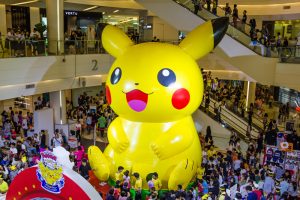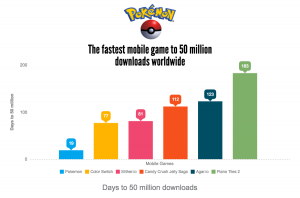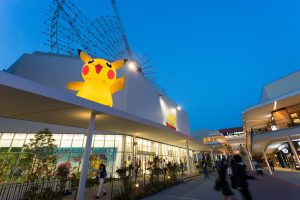You are a CEO at a tech company in San Francisco and have to choose which product team to promote to senior level roles. Which would you choose?
Product Team A:
- 14M downloads
- $20k in daily revenue
- $1.1M total net revenue
Product Team B:
- 100M downloads
- $10M in daily revenue
- $160M in net revenue
There’s no doubting Team A’s success, but Team B’s numbers cast a shadow over its competition like that of a fifteen-story skyscraper towering over a neighborhood apartment complex.
Now what if I told you that Team B’s product is less than 30 days old, compared to 3 years for Team A? Want to know something even more startling? They are essentially the same exact product.
Pokemon Go: Showing Up In Your Neighborhood
Product B is a game called Pokemon Go, a location-based mobile game that turns real-world landmarks into in-game objectives—and one that is all the rage right now.
The game is simple to learn. Using your phone’s GPS, the software causes Pokemon “monsters” to appear on your screen, superimposed on your normal camera view. You “catch” Pokemon by shooting a Pokeball at them while they are inside of a colored ring. If you’re successful, these monsters enter your collection, where you can customize their appearance and vital metrics. The idea, as Pokemon’s catch phrase insists, is to “catch ’em all”. It’s easy to play, addicting (I caught a few just this morning), and is one way or another, likely affecting your current personal life.

Pokemon Go Is Going, Going, Gone
Pokemon Go has made global headlines in the last 30 days. It’s raking in an insane 10M dollars a day, but in all honesty, its total worth could be in the billions. Apple, whose iTunes store stands to make $3B from the downloads alone, recently announced that Pokemon Go had broken the record for most downloads in a week—not just among gaming apps, but of every category. It’s easily surpassed Tinder’s user base in a few short weeks and now has an even more sizable one than the social media behemoth, Twitter.
From a financial point of view, these numbers aren’t impressive; they are groundbreaking.
Waiting on the Sidelines
Companies are avidly looking to cash in on the game’s popularity and the waterfall of profits that are sure to come with it. Local businesses using various “luring” methods to attract Pokemon players to their storefronts are already reporting major bumps in revenue. Yelp even created a filter to help players identify gamer-friendly businesses. Everyone wants a piece of the Pokemon revenue pie.
Want to talk about a payday? Larger corporations will pay good money to have dedicated users spend time in their establishments. McDonald’s is the first company to take advantage of this setup but likely won’t be the last. In an attempt to piggyback on the media’s fixation, travel companies like Marriott Rewards have offered to sponsor the international travel of advanced players.
Putting A Stamp On The World
Gamers aren’t known for hitting the town, but Pokemon Go is pushing gamers to get out and explore their cities. If you’ve seen a large mass of people weaving through oncoming traffic, heads down, with their eyes glued to their phone screens in the past few weeks, you have an idea of what I’m talking about.
Is it annoying to dodge pedestrians paying no mind to the road? Sure. But this game is creating an opportunity for introverted and extroverted players alike to make new friends. Some people are even losing weight as a result of their daily gameplay. Pokemon Go might even be the answer for world peace. Who knows? It’s only been 30 days.

Pokemon Go is No Overnight Success
Fact: Pokemon Go was actually released 3 years ago. Well, sort-of. Remember the previous example with the two lopsided product teams? Product B is a game called Ingress, brought to us by the founders of Pokemon GO. While it hasn’t exactly been a failure, Ingress is over 3 years old and has caused less uproar than it’s counterpart.
The strange thing is—Ingress is essentially the same game as Pokemon Go. Think of Ingress as Pokemon Go’s older and less cool brother, that just so happened to pave the way for its existence.Instead of monsters, Ingress uses aliens. Although Ingress is team-focused, both games guide users to built-in hotspots where they can generate items to help further a mission. These hotspots exist physically and virtually, displayed together in one camera view.
Ingress’ world map was essentially repurposed for Pokemon, and it was Ingress players (can we call them Ingressors?) that indirectly determined the locations of Pokestops in Pokemon Go.
So if Ingress and Pokemon are the same game, why did the latter takeoff? Was it luck? Timing?
John Hanke and Niantic
Pokemon Go’s virality is due to a technological evolution that John Hanke, CEO of Niantic, has been working on for over 30 years. Niantic began in 2010 as a startup within Google before spinning off in 2015 and becoming its own entity. Hanke was a founder of Keyhole, the company that helped create Google Earth and Google Maps. It was Hanke’s experience with mapping that gave Ingress a way to create its virtual landmark concept.
Hanke is no fool, but his decision to partner with Pokemon on a new version of his existing game was based on a joke. On April 1, 2014, shifty tech-giant Google played a little trick on us by integrating a version of Pokemon into Google Maps. Placing Pokemon characters throughout the globe, they released a video asking anyone adventurous enough to find and “catch ’em all.”
The winner would be offered a job at Google. Within a few hours, the joke (and likely publicity stunt) went viral. Hanke knew he had something big on his hands. Furthermore, it was then he was able to witness Pokemon’s fan-power in full force.
Lasting Strength in the Pokemon Brand
Pokemon turned 20 this past February. Created in 1996, it has sold over 200M copies and made $39B in its lifetime. This has made Pokemon the second-most popular video game franchise of all time. You don’t have to look very far to see that the Pokemon brand has kept much of its early popularity. It made over $2B in revenue just last year. Not too bad for a game that was predicted a failure by Nintendo prior to its launch.
Pokemon’s origin doesn’t lie so much in pets or monsters as it does in a love of bugs. The game’s creator, Satoshi Tajiri, came up with the idea for the game after trying to catch small beetles and worms as a child in his native country Japan. Tajiri, who was famously mentored by Donkey Kong and Mario creator Shigeru Miyamoto, gives credit to bugs as his inspiration. “As a child, I wanted to be an entomologist; insects fascinated me”, says Tajiri. The game is therefore rooted in a child-like excitement which would explain its popularity with the youth.

In Branding, Emotions Are Powerful
A great brand is able to elicit emotion from its audience. For those of us that grew up in the 90’s with the original Pokemon game, the nostalgia is overwhelming.
We love Pokemon, but what does that really mean? We love the way the game makes us feel.
Pokemon are basically digital pets. They have unique sizes and shapes, temperaments and personalities. Sure, owning a digital pet isn’t the same thing as owning a real dog or cat, but it’s the next best thing. These Pokemon do the same things our real pets do. They make us laugh, we watch them grow— we take ownership of them.
Who’s able to recite a popular show’s intro theme song (I’m looking at you Fresh Prince of Bel-Air fans)? A brand’s music becomes engrained in our life experience. It makes sense then, that Pokemon related songs have tripled in popularity since the release of Pokemon Go. Music is powerful and a great branding tool. I’d dare to bet there’s a jingle of some kind dancing around in your head right now.
For years, fans followed Pokemon through comic books and television shows. By continuing to provide quality content, Pokemon’s creators kept their audience engaged throughout the years. The show brought emotions out of us, and while it may have been years since we last tuned in, those emotions have a way of surfacing as they have now.
It’s this emotional tie-in between ourselves and the Pokemon brand that’s made the new game’s appeal undeniable.
You Don’t Need a Pokeball to Capture Your Brand’s Identity
Pokemon Go’s popularity is mirrored in the app’s metrics. Average usage is a key performance indicator (KPI) in the mobile app industry. A Pokemon Go-er is on the app for an average of 26 minutes, Conversely, Facebook’ users spend an average of 23 minutes in the Facebook app.
Numbers like these indicate a dedicated fanbase, and one that didn’t just haphazardly stumbled upon the game in the app store.
In other words, the longer a person spends on the app, the greater value for that app. “Truly successful apps offer a clear solution to a problem their users face, with success affirmed by users visiting the app repeatedly,” according to Brant DeBow, EVP of technology at BiTE Interactive. These users are showing Pokemon a rare kind of brand loyalty, like nothing we’ve ever seen before.

Brand Characteristics That Bring Value
What’s important in a brand? A logo design is only the start. Your brand should encompass the following characteristics:
Impassioned: Whether through color or design, when you make people feel something, it will resonate with them forever. There is a saying, “People will never remember the things you said. They will remember how you made them feel.” This holds true with branding as well.
Easy to access. Pokemon Go is free, meaning anyone can download and play it. Your brand should be specific enough to make sense in your industry, yet universal enough to reach any demographic.
Distinct in communication. Ingress’ storyline is fairly complicated, whereas Pokemon’s storyline is overtly simple. “Gotta catch ’em all” is a catch phrase that’s been used for over 20 years, and one gets to the essence of Pokemon. Getting to the point and maintaining one voice throughout your messaging is vital to branding.
Easy to engage. Pokemon Go is easy to learn how to play, and it is addictive. The moves are very basic and so are the goals. Your brand should make it easy for someone new to interact with it and intriguing enough for them to want to immerse themselves in it.
Consistent. The image of a red and white Pokeball has been at the forefront of the Pokemon brand since its inception. The Pokeball can historically be found on almost every product, including the most recent Pokemon Go release. Driving a consistent message is key to brand identification.
Emotions Rule
Augmented reality technology is impressive and will likely shape the future of mass marketing. Pokemon Go is a force— that much is certain, and every tech CEO and marketer wants to be in John Hanke’s shoes right now. Hanke’ success is well deserved; he devoted many years of his life to developing geo-locating technology. Even so, the real story here from a marketer’s perspective is the unwavering strength of the Pokemon brand in the 20 years since its creation. Emotions elicit brand loyalty—and no one knows this better than Pokemon gamers.
The next time you see those impassioned gamers face-down in their phone, keep in mind they’re not just having fun. They’re emotionally invested.

